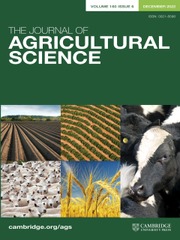Article contents
Traits associated with high yield in barley in low-rainfall environments
Published online by Cambridge University Press: 27 March 2009
Summary
Results are reported from nine field trials carried out in 1985/86 and 1986/87 aimed at identifying plant traits which are associated with high yield in barley in low-rainfall Mediterranean areas. Thirtyseven two-rowed and 35 six-rowed genotypes, representing the known diversity in traits considered to be useful, were compared in trials at three sites differing in expected annual rainfall (212–328 mm) in northern Syria, and in droughted and irrigated trials at Cambridge, UK. Yield, its components and other morphological and developmental traits were measured and correlations calculated.
Grain yields of the two- and six-rowed groups of genotypes were similar at all sites except in the irrigated trial in Cambridge, where the six-rowed genotypes gave the highest yield. Aside from the known difference in number of ears and number of grains/ear between two- and six-rowed genotypes, the simple correlations between grain yield and measured traits suggested that important traits for high yield in two- and six-rowed genotypes in dry environments were prostrate habit, vigorous seedling growth, good ground cover, early ear emergence, many ears/m2 and large grains. In the two-rowed genotypes, short stature and a short grain-filling period were also important, while in the six-rowed genotypes, tall stature, high straw yield, many grains/ear and long peduncles were important. Correlations of these characters with an index of drought susceptibility and with yield adjusted for yield potential and date of ear emergence supported the conclusions based on the simple correlations.
The physiological basis of the correlated traits is discussed and the implications for breeding are considered.
Information
- Type
- Crops and Soils
- Information
- Copyright
- Copyright © Cambridge University Press 1991
References
REFERENCES
- 54
- Cited by

